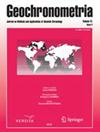日本东北部神喜多海岸平原末次间冰期海相阶地沉积物中钾长石的ir - IRSL定年
IF 0.9
4区 地球科学
Q3 Earth and Planetary Sciences
引用次数: 12
摘要
摘要为了建立适合日本海相阶地沉积的发光测年方案,我们利用日本东北部神喜多海岸平原5e阶地沉积的海洋同位素阶段(MIS)测试了k -长石后红外(IR)红外激发发光(IRSL) (pIRIR)测年的适用性,该阶段具有独立的tephra年龄控制。最常用的pIRIR信号之一,在290°C下测量,第一次红外刺激温度为50°C (pIRIR50/290),其平均g2days值为1.94±0.19%/decade。相比之下,首次红外刺激温度为200℃(pIRIR200/290)的pIRIR信号的衰落率要低得多(g2days = 0.16±0.49%/decade)。两个采样点获得的MIS 5e潮下沉积物未校正和校正后的平均pIRIR200/290年龄分别为126±3 ka和132±2 ka,与独立年龄控制相吻合。我们的结论是,现在不仅可以使用pIRIR协议来估计MIS 5亚阶段(5a, 5c)形成的海洋阶地的年龄,还可以估计年龄证据有限的更老的海洋阶地的年龄。本文章由计算机程序翻译,如有差异,请以英文原文为准。
Post-IR IRSL dating of K-feldspar from last interglacial marine terrace deposits on the Kamikita coastal plain, northeastern Japan
Abstract To establish a suitable luminescence dating protocol for marine terrace deposits in Japan, we tested the applicability of K-feldspar post-infrared (IR) infrared stimulated luminescence (IRSL) (pIRIR) dating using a marine isotope stage (MIS) 5e terrace deposit from the Kamikita coastal plain (NE Japan), where independent age control from a tephra is available. One of the most commonly used pIRIR signals, measured at 290°C with the first IR stimulation temperature at 50°C (pIRIR50/290), faded with a mean g2days value of 1.94 ± 0.19%/decade. In contrast, the pIRIR signal with a higher first IR stimulation temperature of 200°C (pIRIR200/290) had a much lower fading rate (g2days = 0.16 ± 0.49%/decade). The average fading-uncorrected and -corrected pIRIR200/290 ages of MIS 5e subtidal sediments obtained from two sampling sites were 126 ± 3 ka and 132 ± 2 ka, which is in good agreement with the independent age control. We conclude that is it is now possible to use pIRIR protocol to estimate the ages of not only marine terraces formed during MIS 5 substages (5a, 5c) but also of older marine terraces, for which age evidence is limited.
求助全文
通过发布文献求助,成功后即可免费获取论文全文。
去求助
来源期刊

Geochronometria
地学-地球科学综合
CiteScore
2.20
自引率
0.00%
发文量
1
审稿时长
>12 weeks
期刊介绍:
Geochronometria is aimed at integrating scientists developing different methods of absolute chronology and using them in different fields of earth and other natural sciences and archaeology. The methods in use are e.g. radiocarbon, stable isotopes, isotopes of natural decay series, optically stimulated luminescence, thermoluminescence, EPR/ESR, dendrochronology, varve chronology. The journal publishes papers that are devoted to developing the dating methods as well as studies concentrating on their applications in geology, palaeoclimatology, palaeobiology, palaeohydrology, geocgraphy and archaeology etc.
 求助内容:
求助内容: 应助结果提醒方式:
应助结果提醒方式:


